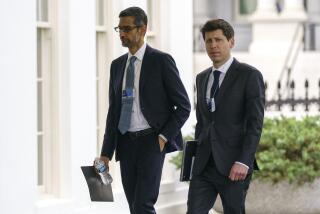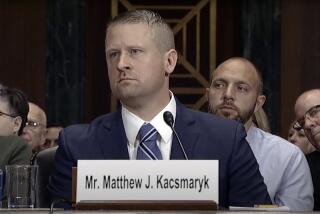A fresh patent manual sought
- Share via
When does a great idea become a patentable invention?
That was a question easier to answer when Thomas Edison came up with the lightbulb and Whitcomb Judson devised the zipper -- Industrial Age innovations that clearly fit with old ideas of what it meant to invent something.
But a recent case before the U.S. Court of Appeals for the Federal Circuit points up the difficulty of making such judgments in the age of the Internet.
Bernard Bilski and Rand Warsaw of WeatherWise USA Inc. in Pittsburgh developed a computerized method for using weather data to predict commodities prices and energy costs. But their efforts to patent the formula were rejected by the U.S. Patent and Trademark Office, a decision upheld by the federal appeals court.
The inventors and their intellectual property lawyers argue that novel business concepts deserve patent protection as much as physical machines that transform industries.
They have petitioned the U.S. Supreme Court to review the appeals court ruling. They say that without the ability to profit from such inventions, the biotech and information services companies that have put such places as Silicon Valley and Redmond, Wash., on the world innovation map won’t be willing to invest in research and development of other breakthroughs.
The patent office’s and court’s rejections of Bilski and Warsaw’s business method patent claim follows years of rather liberal interpretations by patent examiners as to what qualified as an invention. And the new standard imposed, that the invention must involve a machine or a physical transformation, threatens to put the brakes on the busiest area of patent application and analysis. Of the 13,779 “process” patents sought last year, just 1,643 were granted.
Californians hold 24% of the 20-year patents issued in the United States, more than residents of any other state.
The Oct. 30 ruling in the case, referred to in legal shorthand simply as Bilski, already has been cited by the patent office as grounds for rejecting applications on seismic data analysis and a method of converting an Internet domain name to read both left to right, for languages like English, and in the opposite direction, for languages like Arabic and Hebrew.
Before the ruling, patent examiners used the test of whether an invention was “new, useful and not obvious.” Now, they are deciding whether a process is “tied to a particular machine or apparatus, or transforms a particular article into a different state or thing.”
At least four subsequent patent denials based on the Bilski precedent led attorney Michael Jakes, acting on behalf of Bilski, Warsaw and other inventors, to petition the high court, which hasn’t updated its definition of what can be patented for 28 years.
“There are companies out there that have been getting process patents and right now they don’t know if that has value anymore,” Jakes said.
Neither the patent appeals board nor the federal court ruled that business methods can’t be patented, but patent attorneys fear that will be the end result as few would pass the revised test.
“This is one of those rare times in over 200 years of the U.S. patent system that the courts have taken a very constricted view of what is patentable,” said Wayne Sobon, founder of the NewEconomyPatents.org website and director of intellectual property for Accenture, a global management consulting, technology services and outsourcing firm. “A lot of observers, including our company, view that as an undermining of the incentive the patent system was created to provide.”
The biggest problem with the Bilski decision, said Stanford University law professor Mark A. Lemley, is that it has thrown into question all innovations that involve more mental than physical activity, not just those on business methods. That could jeopardize existing patents on some medical diagnostic procedures and scientific data evaluations, as well as withhold patents from future innovations.
“What does it mean to be tied to a machine? If you attach ‘in a computer’ to your application for a process patent, is that enough to pass the machine-or-transformation test? The patent office has been saying no, that you need to show a special machine has been built for this purpose,” Lemley said.
The Supreme Court hasn’t ruled on what is patentable since 1981, Lemley said, leaving the federal appeals courts to apply standards set in the infancy of the information age to complex modern innovations.
“The computer world has changed a lot since 1981. The courts have the power to adapt the law and keep it up with changing technologies, and they had been doing that. But Bilski is a step backward,” Lemley said.
Not all high-tech leaders want Bilski overturned. Although it’s true that health science industries often rely on patents to recover research and development investments, information technology advances move too fast to benefit much from patent protections.
“Patents like the one at issue in Bilski give a bad name to the patent system,” said Horacio Gutierrez, a Microsoft vice president for intellectual property and licensing and deputy general counsel.
Inventor Bilski, arguing for the Supreme Court review, says business methods like his formula are crucial to spurring economic growth. He says the appeals court decision is “a throwback to the 19th century, when our economy was primarily manufacturing-based, and fails to recognize that many inventions are based on ideas not necessarily tied to a machine or piece of equipment.”
--
More to Read
Inside the business of entertainment
The Wide Shot brings you news, analysis and insights on everything from streaming wars to production — and what it all means for the future.
You may occasionally receive promotional content from the Los Angeles Times.











